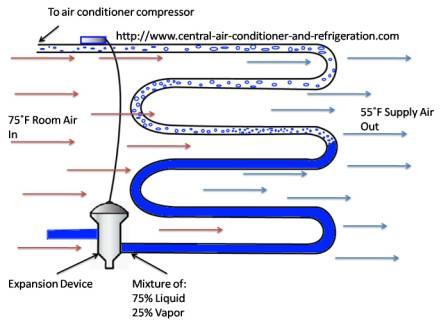Air Conditioner Evaporator Coil
Absorbs heat from the indoor air
So - what is air conditioner evaporator?
Air conditioner evaporator is a heat exchange. It takes in low temperature, low-pressure liquid refrigerant from the expansion device and changes it into low-pressure, low temperature vapor refrigerant.
Evaporator coil is the components that add heat to the air conditioner units.
* Notes: refrigeration is the process of removing heat from one area where it is undesirable to an area where it is not significant. For this process to work, heat has to flow from one area (medium) to another.
To make heat flows, one of the mediums has to be at a higher temperature. Since, heat always flows from a high intensity to a low intensity.
Types of air conditioner evaporator:
- Director-expansion or Air-cooled Evaporator
- Flooded evaporators
How does air conditioning evaporator works?
Air conditioning evaporator works by absorb heat from the area (medium) that need to be cooled. It does that by maintaining the evaporator coil at low temperature and pressure than the surrounding air.
Since, the AC evaporator coil contains refrigerant that absorbs heat from the surrounding air, the refrigerant temperature must be lower than the air.
The expansion device provides a pressure reduces between the high side and the low side of the system, the saturation temperature of the refrigerant entering the air conditioning evaporator is lower than the medium to be cooled.
One of the characteristic of an ac refrigerant is that as the pressure is reduced the boiling point is also reduced. Therefore, as the pressure is reduced through the expansion device so is the point at which it will boil and become a vapor.
As the warm air from the space passes over the evaporator coil, it gives up its heat to the lower temperature liquid/vapor mixture passing through the evaporator. As the liquid refrigerant absorbs this heat it boils changing from the liquid state to the vapor state.
The amount of heat the air conditioner evaporator absorbs must equal the amount of heat it lost
For instance, if the air conditioning evaporator gives up 100 Btu’s of heat to the surrounding hot air, then the refrigerant within the air conditioning evaporator coil must gain 100 Btu’s of heat.
The amount of liquid entering the evaporator must be enough, so by the time it reaches the end of the evaporator. It will be completely boiled to the vapor state.
There must be enough air flows across the AC evaporator coil to provides heat to the refrigerant in the evaporator coil. This is just a safety way to ensure the air conditioner compressor doesn’t have the liquid refrigerant entering it.

Air conditioning evaporator picture above tells us what happen to the evaporator coil.
The evaporator coil absorbs heat into the refrigerant from the warmer air passing over the surface of the evaporator coil. The heat absorbed causes the liquid refrigerant to boil, changing it from a liquid state to a vapor state.
Other air conditioning evaporator coil:
- Bare-tube coils
- Finned-tube coils
- Flat-plate coils
Read other central ac part relative to this:
Return to central air conditioner and refrigeration